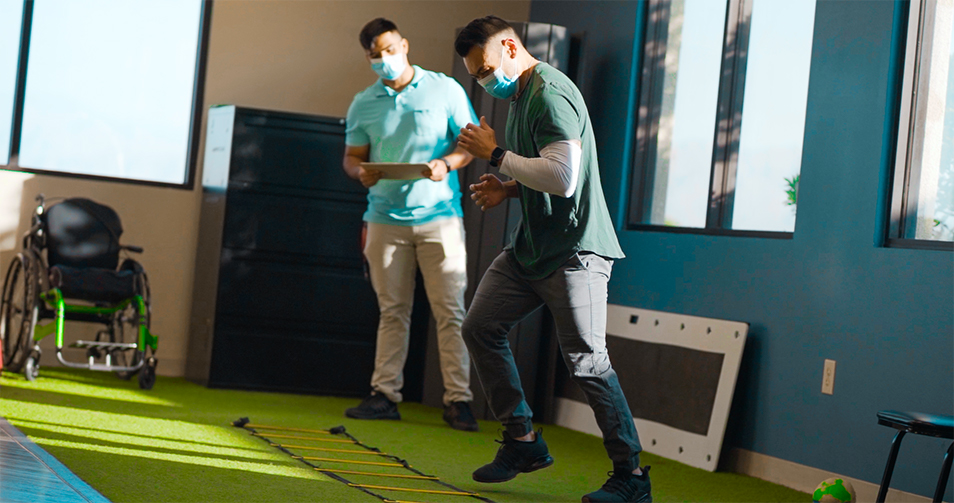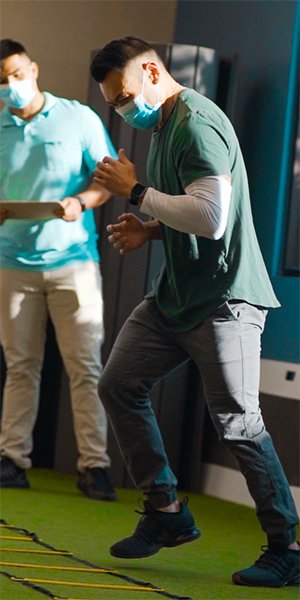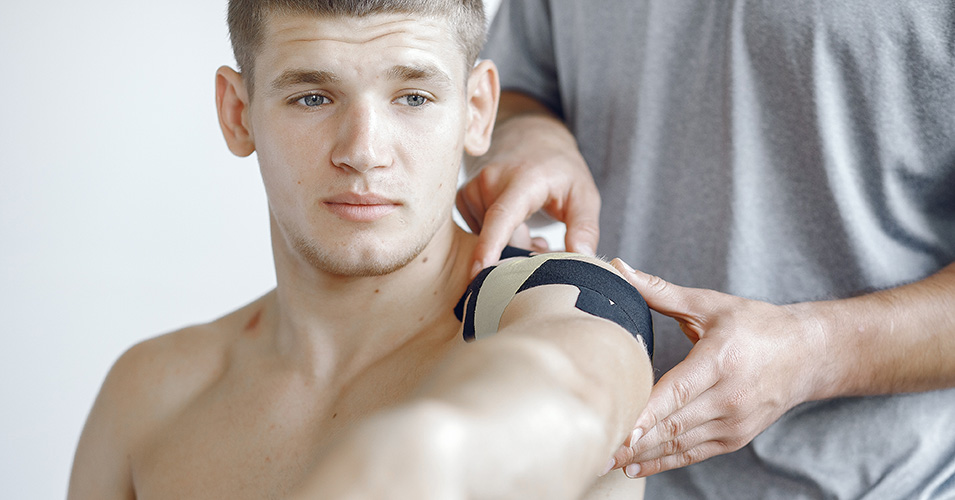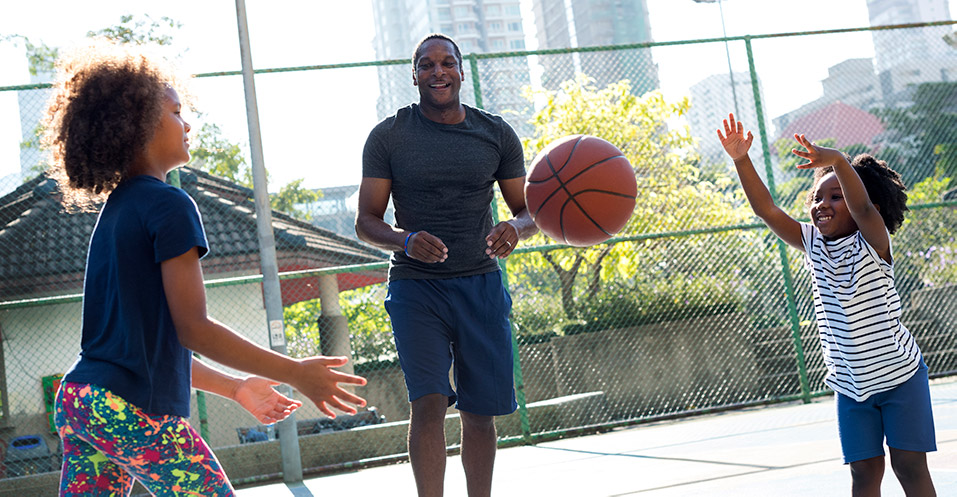Sports Physical Therapy
When playing sports, we push our bodies to the limit. Our therapists can help you go push further and do so safely.



Whether you are a professional athlete or a weekend warrior, all athletes run the risk of a sports-related injury. Don’t let a sports injury keep you from playing the game. At Optimal Therapy we will help you treat your injury with a customized sports physical therapy program and prevent it from becoming a recurring problem.
Sports rehab focuses on the prevention, evaluation, treatment, and rehabilitation of sports injuries, for anyone that has an active lifestyle. Athletes can be effectively treated using physical therapy to restore activity, strength and motion after an injury.
Optimal Therapy provides many options and plans to help you get back to your sport/activity of choice, or help you improve your level of performance to be at your best. Treatment options include:
Blood flow restriction training is an evidence-based form of training that promotes improvements in strength and endurance at a lower intensity level of exercise by limiting the amount of blood flow supplied to the muscle being targeted. Blood Flow Restriction (BFR) Training has been proven to increase strength and muscle size, decrease rehabilitation time, improve cardiovascular endurance, and increase the rate of recovery after strenuous exercise or athletic events.
Your Physical Therapist will begin by discussing your past medical history to verify that BFR is safe for you. A cuff will then be fastened around the top of your arm or leg and pumped up until maximal occlusion of blood flow is measured. The therapist will then adjust the pressure in the cuff so that only a certain percentage of blood flow is restricted to the muscles while you exercise. Exercise with BFR is not painful; however, you will experience fatigue at a faster rate.
By reducing the blood flow to a limb and completely occluding the flow out of the limb, muscles are metabolically stressed, therefore mimicking a more intense exercise than what is actually being performed. As a result, the body recruits more muscle fibers, metabolite concentration increases, and muscle strength and growth are stimulated.
Extensive research has been conducted regarding the safety of BFR. BFR is not advised if you have cancer, unmanaged hypertension, lymphedema, active infection, impaired circulation, history of DVT, and other cardiac conditions.
Blood flow restriction training is safe and effective for a wide range of populations and conditions including but not limited to:
Myofascial release includes any form of therapy aimed to decrease muscular tension and fluid build-up in the targeted muscle or muscle groups. An increasingly popular technique known simply as Cupping, is a traditional Chinese therapy that has been adapted to the field of Sports Medicine. It has become so popular among professional athletes, that the majority of Olympic hopefuls at the 2016 Rio Olympics —including Michael Phelps—requested Cupping as part of their maintenance recovery programs.
At Optimal Therapy, our therapists use a type of cupping called Air Cupping or Vacuum Cupping. Air Cupping has been beneficial in a variety of injuries including chronic low back pain, fibromyalgia, migraines, cervical spondylosis, and other myofascial soft tissue injuries. Air cupping is used to promote healing and blood flow to the injured area. Cupping can:
Placing the cups on the body increases blood flow to the injured area and draws toxins from the deeper tissue to aid in healing. The negative pressure from the cups lifts the fascia to stretch it and allow for lymphatic drainage of toxins. Restoring normal tissue movement can eliminate pain as well as any mechanical deficiencies caused by the restricted soft tissue.
There are a few different cupping techniques that can be used: some are more passive (the cups are placed on areas of tension and not moved for the duration of treatment), and some are more active and aggressive (after placing the cups on certain restricted areas, the patient is asked to perform an active movement).
Note: Cupping can result in deep red circles where the cups were placed, indicating that toxins and other cellular debris have moved from deeper tissue layers to the surface. Circles could last for up to a week or more, and are not painful, with the exception of some minimal initial soreness.
Cupping is one modality that may be used as part of your traditional Physical Therapy treatment. Use of Cupping and other modalities will be determined by your Optimal Therapist at time of treatment.

Kinesio Taping (KT) is a rehabilitative taping technique designed to facilitate the body’s natural healing process while providing support and stability to muscles and joints. It can be used to decrease pain and inflammation, relax overused or tired muscles, and support muscles in unrestricted movement.
KT Taping can be used as an adjunctive treatment for any patient with mechanical pain, but works particularly well with overuse injuries. Any area of soft tissue (muscle or tendon) can be taped. At Optimal Therapy the therapists may use Kinesio Taping with the following conditions:
Taping the body activates proprioceptors, or sensory receptors that provide information about the position of the body and its parts in space at a particular moment in time. When these get turned on, a message goes out to the brain to improve muscle function and in return, decrease the amount of pain you are experiencing.
Once your therapist measures, cuts, and places the tape on your body, it can be worn for up to 5-7 days, with no limit to range of motion, and virtually no limitations (you can shower with it, work out with it, etc.). Tape is designed to be waterproof and friction resistant.
Kinesio Taping is one modality that may be used as part of your traditional Physical Therapy treatment, and is billed through your insurance. Some patients elect to buy the KT tape and apply it on their own or with the help of a friend or family member. The proper use of taping and other modalities will be determined by your Optimal Therapy therapist at time of treatment.
Dry needling is often confused with acupuncture; however, they are very different techniques. Dry needling focuses on reducing pain and accelerating healing through a deep understanding of the relationships between our bodies and our central nervous system. Specifically, dry needling is another form of soft tissue mobilization that can help reduce inflammation, decrease muscle tension, and ultimately relieve pain.
Dry needling uses a very thin needle to stimulate trigger points in connective tissue. The goal of dry needling is to release tension on tight muscle bands associated with trigger points that are causing pain. Trigger points can make it painful to perform everyday activities and often radiate pain to other areas of the body. Dry needling focuses on stimulating those trigger points, which has been shown to reduce pain and speed up your recovery process.

Optimal Therapy performs evidence-based testing to help determine your readiness for returning to sports/competition following an injury. Without proper rehabilitation and return to play assessment, there is a very high likelihood of re-injury to the involved or even the uninvolved limb. “Return to Play” is also referred to as “Return to Sport.”
We will perform a variety of evidence-based tests, which can take up to 60 minutes. Tests include:
If your Return to Play testing concludes that you are NOT yet ready to play sports, Optimal Therapy will continue to work with you on strength training, plyometric training, and working on hopping and mechanics that will get you back in the game!.
Note: The ideal time to consider Return to Play Testing is 9-12 months after ACL reconstruction surgery. (If there is anything worse than an ACL tear, it is a re-tear.)
Return to Play testing is billed through insurance like a regular physical therapy session.
If you have any questions about sports and athletic physical therapy, please contact us today.
If you want to skip the wait, you can reach our scheduling team Monday through Friday from 9am – 5pm.